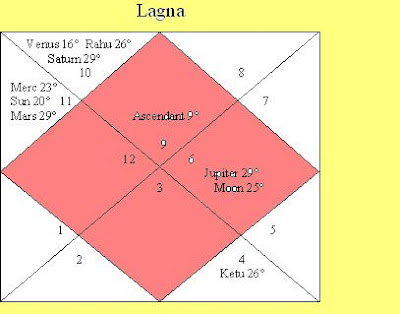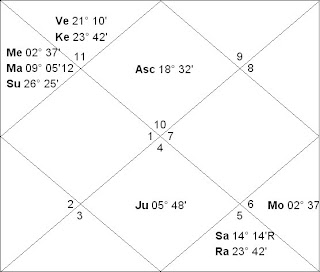Female, DOB 5 January 1969, 11:45 am, Provins, France
This individual has Pisces in the ascendant at 5 deg 17 min with Rahu and Saturn. Moon is in Cancer in the fifth house, Ketu and Jupiter in the seventh, Mars in the eighth, Sun in the tenth, Mercury in the eleventh and Venus in the twelfth.
The sub-period of Rahu is operating in the major-period of Venus.
The question is how to determine the transit effects of Rahu.
The first issue is to determine the houses that a Node would influence. There is a difference of opinion on the houses that a Node projects an aspect to. Some say the aspects are on the 2, 5, 7, 9, and 12 houses from the place of the Node; others say that it is only on the 5, 9, and 12 and so on. So, without entering the controversy we should take the houses the results of which an unassociated Node would give as follows: the house the Node occupies, the house where its dispositor is placed, the house that the owner of the constellation occupied by the Node occupies and the house determined by the sign that the Node occupies in the navamsha chart and the house where the owner of the navamsha sign is placed. We will explain these through the above illustration.
In the above chart, the Node:
(i) Occupies the ascendant;
(ii) It is placed in the sign of Jupiter which is placed in the seventh house;
(iii) Rahu is in a constellation of Saturn which is also in the first house;
(iv) Rahu is in Libra navamsha. This sign is placed in the eighth house in the birth chart. Hence Rahu will give results relating to the eighth house from the ascendant.
(v) Venus owns the sign that Rahu occupies in the navamsha chart. Venus is placed in the twelfth house from the ascendant. Rahu will be related to this house as well.
Rahu is thus related to the I, VII, VIII and XII houses from the ascendant.
Taking Venus (major-period planet) as the ascendant Rahu should give results of the II, VIII, IX and I houses.
Since Rahu is associated with Saturn in the chart all the houses that Saturn operates through occupation, aspect, constellation and navamsha will also operate in the sub-period of Rahu.
The above is the analysis of the likelihood of the houses the results of which may appear in the sub-period of Rahu in the major-period of Venus. Now, what happens when Rahu in transit enters Sagittarius. As of now (Jan 11, 2010) Rahu is in Sagittarius and this is the eleventh house from natal Venus. Hence Rahu will give results of the eleventh house.
Jupiter is in Aquarius (the major-period planet ascendant). Hence Rahu will give results of the first house.
Further, Rahu is placed in a sign of Jupiter so it gives again the results of the first house from natal Venus.
Rahu is in a constellation of the Sun which is in Sagittarius hence the above conclusion will be reiterated.
Rahu is in Sagittarius navamsha.
Rahu will therefore give results in its current transit of the first and eleventh houses. This is valid till Jan 14 when the Sun changes sign and a fresh analysis is required to be carried out.






